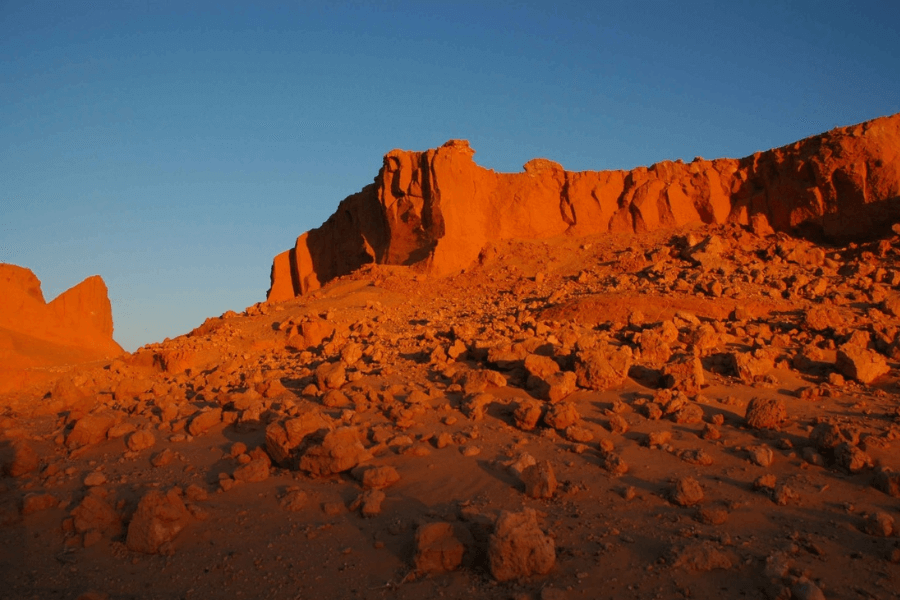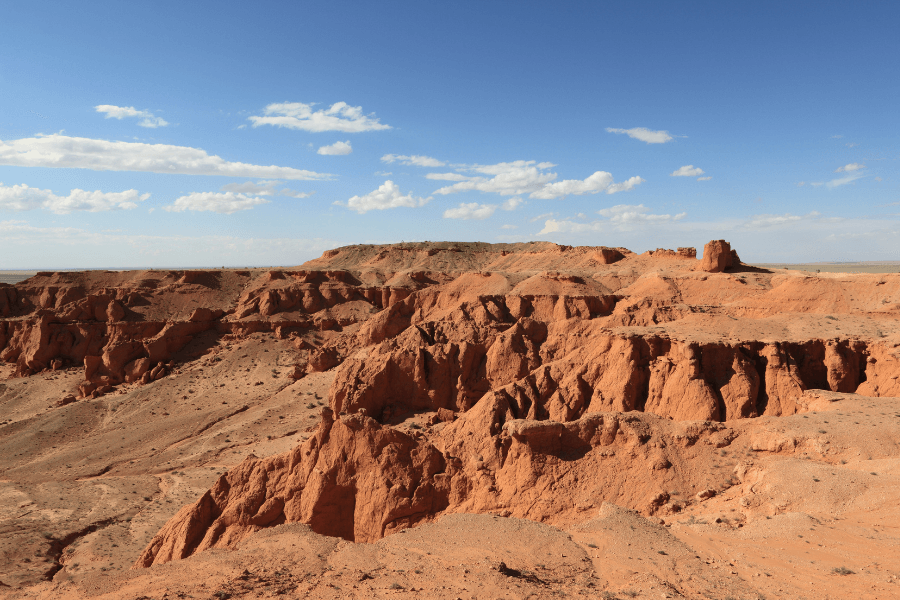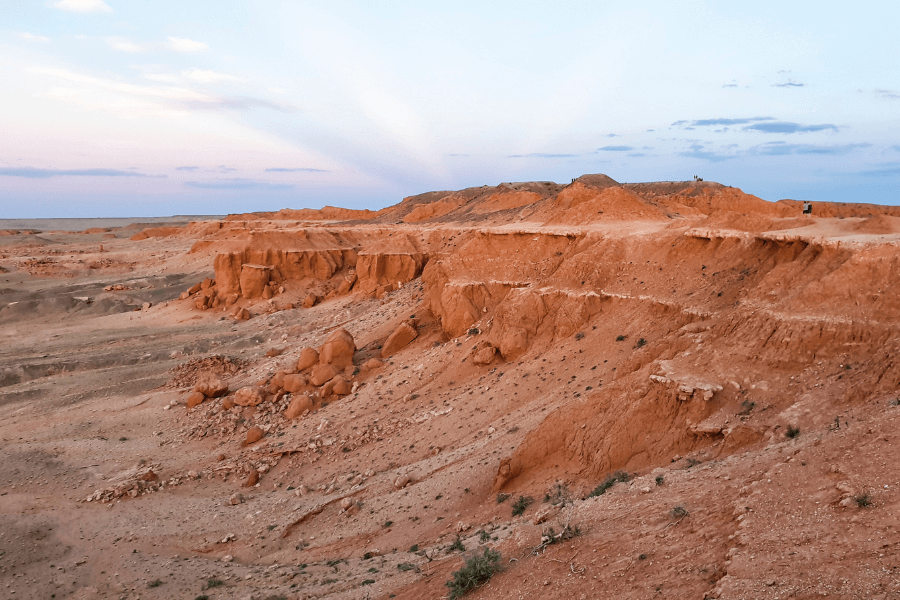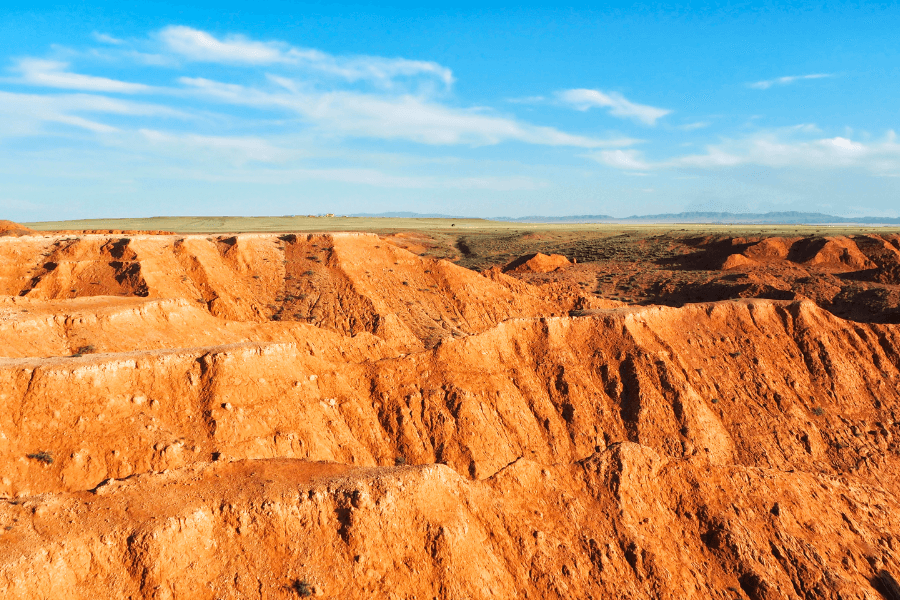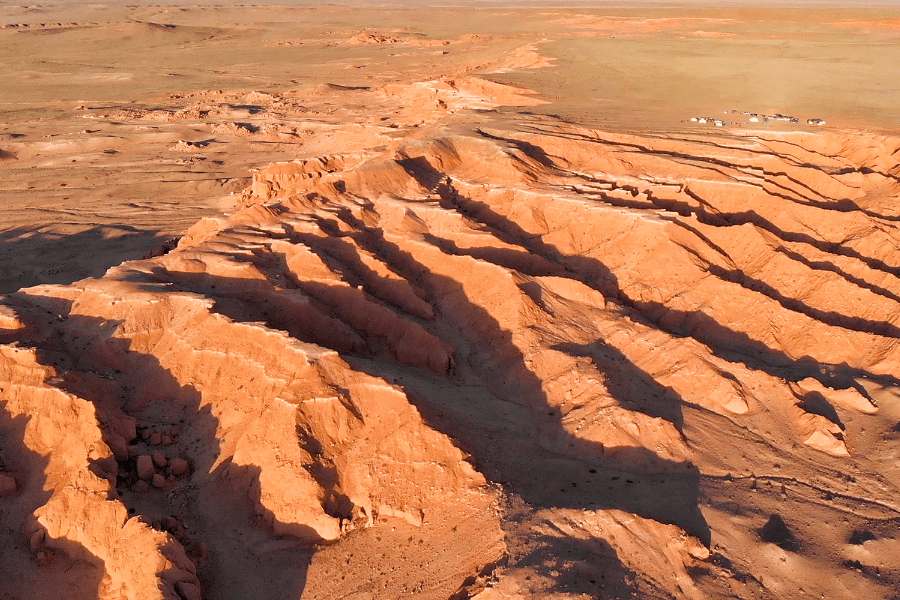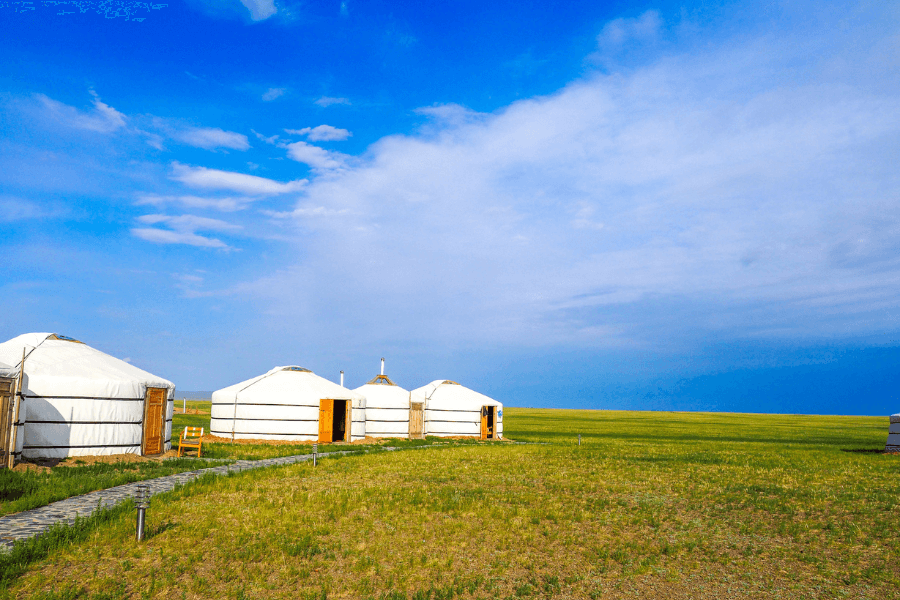Nestled in the heart of Mongolia's Ömnögovi Province, Bayanzag Flaming Cliffs stand as a testament to the region's rich natural and cultural heritage. Also known as Bayanzag, this iconic destination is renowned for its striking red sandstone formations that stretch across the desert landscape, creating a breathtaking panorama against the vast expanse of the Gobi Desert. Visitors to Bayanzag Mongolia can embark on our tour packages Mongolia that offer a comprehensive exploration of this fascinating site.
Introduction About Bayanzag Flaming Cliffs
Bayanzag Mongolia, also known as the Flaming Cliffs, is a treasure trove of natural beauty and historical significance. The name "Flaming Cliffs" aptly describes the vibrant hues that illuminate the landscape, especially during sunrise and sunset when the cliffs appear to be ablaze with fiery colors. This spectacle has made Bayanzag Flaming Cliff a favorite destination for photographers and nature enthusiasts alike.
Bayanzag Flaming Cliff is not only visually stunning but also holds immense paleontological importance. It gained international fame in the 1920s when American explorer Roy Chapman Andrews discovered the first dinosaur eggs and fossils here. Since then, Bayanzag Mongolia has been a hotspot for dinosaur fossil discoveries, including those of the famous velociraptor and Protoceratops.
Visitors to Bayanzag have the opportunity to explore the ancient seabed where these fossils were preserved. Guided tours offer insights into the area's rich paleontological history and the chance to see fossilized dinosaur remains firsthand.
In addition to its paleontological wonders, Bayanzag Flaming Cliff offers visitors the chance to experience the vastness and solitude of the Gobi Desert. Camel treks, hikes, and overnight stays in traditional ger camps allow travelers to immerse themselves in the unique landscapes and nomadic culture of Mongolia.
How was Bayanzag Flaming Cliffs Formed
The Bayanzag Flaming Cliffs, a renowned geological marvel in the heart of the Mongolian Gobi Desert, were formed over millions of years through a combination of geological processes and environmental factors. At the core of this iconic landscape is an escarpment, along which Upper Cretaceous sediments crop out, creating a distinctive morphological boundary between the desert steppe zone above and the desert basin floor below.
Comprising alternating sandy and calcareous beds, the Flaming Cliffs are characterized by their vivid reddish-orange hue, a result of the iron-rich minerals present in the sedimentary rocks. This striking coloration is particularly prominent during sunset, when the cliffs appear to be ablaze with fiery hues, hence earning them their evocative nickname.
The formation of the Flaming Cliffs can be traced back to ancient geological processes, including sedimentation, erosion, and tectonic activity. Over time, layers of sediment were deposited in the region, eventually forming the distinctive sandstone formations visible today. Subsequent erosion by wind and water sculpted the landscape, exposing the layers of sediment and creating the dramatic escarpment that defines the Flaming Cliffs.
The significance of Bayanzag Flaming Cliffs extends beyond its geological beauty, as it has also played a pivotal role in scientific exploration and discovery. In the early 20th century, the cliffs gained international fame as a hotspot for archaeological and paleontological expeditions led by renowned explorer Roy Chapman Andrews. Encouraged by his colleague Henry Fairfield Osborn, Andrews conducted groundbreaking dinosaur skeleton hunting expeditions in the Mongolian Gobi Desert, unearthing a wealth of prehistoric treasures and contributing to our understanding of Earth's ancient past.
Location of Bayanzag Flaming Cliffs
Nestled within the vast expanse of the Gobi Desert, Bayanzag Flaming Cliffs is located in the Ömnögovi Province of southern Mongolia. This iconic geological formation stretches over a wide area, characterized by its striking red sandstone cliffs that stand out vividly against the desert backdrop. Bayanzag is situated approximately 100 kilometers northwest of Dalanzadgad, the provincial capital of Ömnögovi Province. Access to the site typically involves traveling by road, either through organized tours or private transportation arrangements.
Best time to Visit Bayanzag Flaming Cliffs
The best time to visit Bayanzag Flaming Cliffs in Mongolia is during the spring and autumn months, from April to June and September to October. During these periods, the weather is typically mild, with comfortable temperatures ranging from 15°C to 25°C, making outdoor exploration of the desert landscape more enjoyable. Additionally, spring and autumn offer ideal conditions for viewing the stunning sunrise and sunset displays that illuminate the Flaming Cliffs in vibrant hues of red and gold, creating a mesmerizing spectacle that captivates visitors.
Moreover, these seasons coincide with lower tourist numbers, allowing for a more serene and intimate experience amidst the breathtaking scenery of Bayanzag. Whether marveling at the geological wonders or embarking on a fossil-hunting adventure, spring and autumn provide the perfect backdrop for an unforgettable journey to Bayanzag Flaming Cliffs in Mongolia.
Getting to The Bayanzag Flaming Cliffs
Getting to the Bayanzag Flaming Cliffs in Mongolia is an adventure in itself, offering travelers the opportunity to traverse the vast and rugged landscapes of the Gobi Desert. The journey typically begins from the provincial capital of Ömnögovi Province, Dalanzadgad, which serves as the gateway to Bayanzag.
From Dalanzadgad, travelers can embark on a scenic drive through the desert terrain, with the Flaming Cliffs situated approximately 100 kilometers northwest of the city. While the distance may seem short, the journey often takes several hours due to the unpaved roads and rugged terrain.
Alternatively, guided tours and organized excursions are available for those seeking a hassle-free way to reach Bayanzag. These tours often include transportation from Dalanzadgad to the Flaming Cliffs, along with knowledgeable guides who provide insights into the region's geological and paleontological significance.
For those with a spirit of adventure, camel treks and hiking expeditions offer an immersive way to experience the desert landscape en route to Bayanzag. These journeys allow travelers to appreciate the vastness and beauty of the Gobi Desert while making their way to the iconic Flaming Cliffs.
What To Do in Bayanzag Flaming Cliffs
Near the iconic Flaming Cliffs in Mongolia's Gobi Desert, visitors have the opportunity to engage in a variety of unforgettable activities, immersing themselves in the natural beauty and unique landscapes of the region. Here are some of the top activities to do near Flaming Cliffs:
Camel Riding
Experience the timeless allure of the Gobi Desert with a camel ride, a quintessential activity that offers a glimpse into the nomadic way of life. Traverse the desert sands atop a Bactrian camel, marveling at the majestic Flaming Cliffs in the background as you create lasting memories against the backdrop of this stunning landscape.
Watch the Beautiful Sunset
Witness a breathtaking sunset over the Flaming Cliffs, a moment of unparalleled beauty that paints the sky in hues of orange, pink, and gold. As the sun dips below the horizon, casting an ethereal glow across the desert landscape, immerse yourself in the tranquility and serenity of this remote wilderness.
Stargazing
Escape the hustle and bustle of city life and embark on a mesmerizing journey through the cosmos with a night of stargazing in the Gobi Desert. The Flaming Cliffs region offers unparalleled opportunities for observing the night sky, with its clear, unpolluted air providing a perfect canvas for viewing billions of stars and the Milky Way in all its celestial splendor.
Hiking
Lace up your boots and set out on a hiking adventure through the rugged terrain surrounding the Flaming Cliffs. Explore hidden canyons, wind-sculpted rock formations, and ancient desert landscapes as you discover the natural wonders of the Gobi Desert on foot.
Fossil Hunting
Channel your inner paleontologist and embark on a fossil-hunting expedition in search of prehistoric treasures scattered throughout the Flaming Cliffs area. Keep your eyes peeled for dinosaur bones, eggs, and other fossilized remains as you uncover the secrets of Mongolia's ancient past.
Some Facts about Bayanzag Flaming Cliffs
Bayanzag Flaming Cliffs, nestled within the vast expanse of Mongolia's Gobi Desert, is not just a stunning natural landmark but also a treasure trove of prehistoric wonders. Here are some fascinating facts about Bayanzag and its rich paleontological heritage:
Land of Dinosaurs
Bayanzag is aptly nicknamed the "Land of Dinosaurs" due to the numerous dinosaur fossils discovered at this site. These fossils provide valuable insights into the ancient ecosystems and biodiversity of the region during the Cretaceous period, around 120 to 70 million years ago.
Protoceratops and Velociraptor
Among the notable dinosaur fossils unearthed at Bayanzag are the Protoceratops, a dog-sized herbivore with a bird-like beak, and the Velociraptor, a sharp-clawed predator famously featured in the Jurassic Park films. It is believed that Velociraptors hunted Protoceratops in this region.
Oviraptor Nesting Grounds
Bayanzag is also known for its association with the Oviraptor, a dinosaur whose name means "egg stealer." The first Oviraptor fossil discovered here was found fossilized with a nest of eggs, which were later determined to be its own. This finding suggests that Oviraptors used Bayanzag as a nesting ground to hatch their young.
Part of the Nemegt Basin
Bayanzag is situated within the vast Nemegt Basin, where numerous dinosaur fossils, including those of Tyrannosaurus Bataar, have been unearthed. The fossils found in this region provide valuable evidence of the diverse dinosaur species that once roamed the area.
Evidence of Ancient Climate
Fossils discovered in the sedimentary rocks of the southern Gobi, including Bayanzag, indicate that the region had a different climate and environment during the Cretaceous period. The presence of freshwater resources and evidence of a humid climate suggest that the area was ideal for supporting diverse dinosaur populations.
Other Paleontological Sites
In addition to Bayanzag, several other locations in the southern Gobi, such as Bugiin Tsav, Togrigiin Shiree, Ulaan Tsav, and Khermen Tsav, have yielded significant dinosaur fossils. These sites contribute to our understanding of Mongolia's rich paleontological heritage and its importance in unraveling the mysteries of Earth's ancient past.
Accommodations Near Bayanzag Flaming Cliffs
When visiting the Flaming Cliffs (Bayanzag) in Mongolia’s Ömnögovi Province, there are several budget-friendly accommodation options available for travelers. One popular choice is staying in ger camps, which are traditional Mongolian felt tents that offer a unique and authentic experience. These ger camps are scattered around the area near the Flaming Cliffs and provide basic amenities such as a bed, heating stove, and shared bathroom facilities. Staying in a ger camp allows visitors to immerse themselves in Mongolia’s nomadic culture while keeping costs relatively low.
Additionally, there are guesthouses and homestays located in nearby villages like Bulgan and Dalanzadgad that offer affordable lodging options for travelers on a budget. These accommodations provide a comfortable place to stay with a local touch, and guests can interact with friendly Mongolian hosts to learn more about the region’s culture and way of life. Overall, budget-conscious travelers visiting the Flaming Cliffs in Ömnögovi Province have a variety of accommodation options to choose from, ranging from ger camps to guesthouses, ensuring a memorable and cost-effective experience in this stunning desert landscape.
Tips For a Memorable Visit to Bayanzag Flaming Cliffs
Visiting Bayanzag Flaming Cliffs in Mongolia offers a unique and unforgettable experience, but proper planning can enhance your trip. Here are some tips to make the most of your visit:
Choose the Right Time
Consider visiting during the spring or autumn months (April to June and September to October) when the weather is mild and ideal for outdoor activities. Avoid extreme temperatures in the summer and harsh conditions in the winter.
Pack Appropriately
Be sure to pack sunscreen, sunglasses, a hat, and plenty of water to protect yourself from the sun and stay hydrated during your exploration of the desert landscape. Comfortable walking shoes are also essential for hiking and exploring the area.
Arrange Transportation
Plan your transportation to Bayanzag in advance, whether through a guided tour, rental car, or public transportation. Keep in mind that the roads may be rugged, so choose a vehicle that can handle the terrain.
Respect Local Customs
Bayanzag is located in a remote area of Mongolia, so be respectful of local customs and traditions. Ask for permission before taking photos of people or their property, and avoid littering or disturbing wildlife.
Stay Overnight
Consider staying overnight in a ger camp or guesthouse near Bayanzag to fully immerse yourself in the desert landscape and enjoy stargazing under the clear night sky.
Explore Safely
Take caution when hiking or exploring the Flaming Cliffs, as the terrain can be rugged and uneven. Stay on marked trails and be mindful of your surroundings at all times.
By following these tips, you can have a safe and enjoyable experience while visiting Bayanzag Flaming Cliffs in Mongolia, creating memories that will last a lifetime.
From camel rides across the desert sands to hiking excursions amidst the rugged terrain, there are endless opportunities for adventure and discovery at Bayanzag Flaming Cliffs. Whether marveling at the vibrant hues of sunset painting the cliffs in fiery tones or uncovering ancient fossils hidden among the sands, a visit to Bayanzag promises an unforgettable journey through Mongolia's enchanting landscapes and ancient history.

